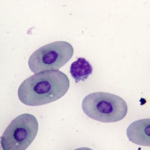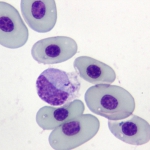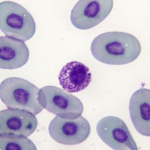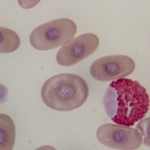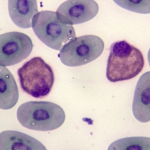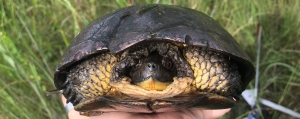
Most of our data collecting is complete and we are on to analysis! It was slightly sad to move out of our Lake County “mansion” and away from our 8 other phenomenal roommates, but cleaning out our bedrooms and field lab reminded us of all that we have accomplished this summer. Here’s a summary of what three months of field and lab work resulted in:
- Data collection from 231 unique Blanding’s turtles
- 331 physical exams performed
- 331 blood samples collected
- 331 PCV/TP assessed
- 4,000,000 hemocytometers read (at least it felt like it)
- 800+ blood smears made
- 662 oral-cloacal swabs taken
We also had the unique privilege to sample a set of the same 50 turtles over the course of three months through the use of telemetry which, along with contributing to a cross-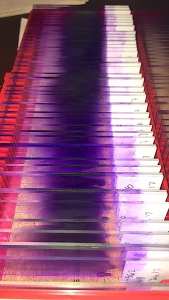 sectional analysis of Blanding’s health, will allow to monitor for changes in the health of these turtles over time. This project is focused on determining what is “normal” for Blanding’s of Lake County in terms of white blood cell levels and ratios, blood chemistry, PCV/TP, clinical signs, and disease prevalence. Hopefully with our data we will be able to get a good idea of base lines for these values and make comparisons between age classes, sexes, locations, and trends over time.
sectional analysis of Blanding’s health, will allow to monitor for changes in the health of these turtles over time. This project is focused on determining what is “normal” for Blanding’s of Lake County in terms of white blood cell levels and ratios, blood chemistry, PCV/TP, clinical signs, and disease prevalence. Hopefully with our data we will be able to get a good idea of base lines for these values and make comparisons between age classes, sexes, locations, and trends over time.
Since we’ve been back, we have been hard at work compiling our files, making sure all data is entered correctly, and working hard on our lab work for our individual projects. We have selected our samples with complete physical exams, blood work and demographic information to use in our final analysis. Since compiling this list we have begun our individual studies.
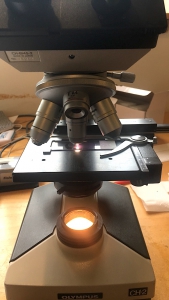 Lauren has been reading blood smears to ascertain the percentage of each kind of leukocyte present in the blood of each individual. Five types of WBC’s important in the immune response are observed and accounted for: lymphocytes, monocytes, basophils, eosinophils, and heterophils (mammalian neutrophil equivalent). Because reptiles are awesome and have uniquely different blood than mammals these must be manually counted from a blood smear with a microscope and cell counter. There is a lack of primary literature on Blanding’s turtle health, and further chelonians in general. My project hopes to establish baseline hematology in efforts to be a reference range for Blanding’s turtles and other similar reptiles. As a state-endangered species, defining baseline health can be critical to help recover and maintain populations, as well as conserve the ecosystems in which they contribute to.
Lauren has been reading blood smears to ascertain the percentage of each kind of leukocyte present in the blood of each individual. Five types of WBC’s important in the immune response are observed and accounted for: lymphocytes, monocytes, basophils, eosinophils, and heterophils (mammalian neutrophil equivalent). Because reptiles are awesome and have uniquely different blood than mammals these must be manually counted from a blood smear with a microscope and cell counter. There is a lack of primary literature on Blanding’s turtle health, and further chelonians in general. My project hopes to establish baseline hematology in efforts to be a reference range for Blanding’s turtles and other similar reptiles. As a state-endangered species, defining baseline health can be critical to help recover and maintain populations, as well as conserve the ecosystems in which they contribute to.
- Lymphocyte
- Monocyte
- Basophil
- Eosinophil
- Heterophil
Lauren’s high of the summer: Being able to give an identifying name to the turtles I personally hand-captured and trapped was fun. What was more fun, was finding them again – a moment to reminisce knowing that the turtle you named was still out there! I named many of the turtles for special reasons including Dala and Punky after my two amazing Grandmother’s, and Esprit after my first family pet. Oh, and getting third place in Blanding’s Bowl was pretty awesome too!
Lauren’s low of the summer: Looking back at my lows now, I think they were more entertaining than anything – weeks of leaky waders, struggling over hemocytometers, having to text Dr. Allender because we lost, or broke, or screwed something up… but I think the hardest thing was when I went on vacation. FOMO is real! Plus, I left John to fend for himself during a couple crazy days of sampling and I felt a tad guilty. Being home with my family is something I love and would do again in a heartbeat, but it was hard to be away knowing fun in the field was happening.
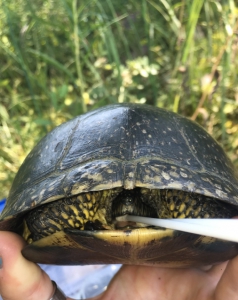
John has been working with the oral and cloacal swabs we have been collecting all summer. The swabs should be picking up whatever pathogens that might be present in our turtle’s mouths and cloacas. From these swabs, we can extract the DNA of the pathogens through a process involving a lot of delicate pipetting and John listening to comedy albums. From that extracted DNA, we should then be able to determine which pathogens we had picked up on the swab using a fancy machine that can test for an array of 19 different pathogens. Three infections we are focusing on are Ranavirus, Mycoplasma, and herpesvirus because these are known to be causes of upper respiratory tract infections in turtles, which can be deadly. Also, Mycoplasma and herpesvirus recur in times of stress and so they can serve as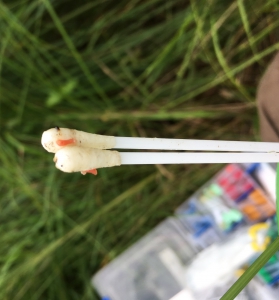 indicators of the quality of overall population health. So John has been finishing and testing his swab DNA extractions for DNA concentration and quality before being sent off to be scanned for an array of pathogen DNA. We hope to have those results back soon and then on to statistical analysis and paper writing!
indicators of the quality of overall population health. So John has been finishing and testing his swab DNA extractions for DNA concentration and quality before being sent off to be scanned for an array of pathogen DNA. We hope to have those results back soon and then on to statistical analysis and paper writing!
John’s high of the summer: It’s hard to identify one high point of the summer so I’ll list a couple. Learning how to trap, track, and take samples efficiently in the field was definitely something I am grateful for and know they will be good skills to have in the future! I also loved getting to get hands on time with turtles every single day and getting to name certain turtles! And of course, one of my highs was getting to know all the people we got to work with this summer. I’ve learned so much from being taught technical skills and even from talking in the cars on the way out to the field in the morning. It was a great summer all around!
John’s low of the summer: My low for the summer would be realizing it was over on the last day. It will be sad to not go out in the field and see our turtle friends every day, but exciting to finally analyze our data!
But Lake County hasn’t gotten rid of us just yet as we will be going back for more sampling right before school begins at the end of August! We will be collecting a fourth round of samples from the telemetered turtles to strengthen our analysis of health trends over time. Right now, I think both of us have enjoyed having a few weeks off from wearing waders but I know we’ll both be glad to get a final plunge into the field before starting back in the classroom for the year.
That’s all for now folks! We hope you have enjoyed following us this summer as much as we have enjoyed sharing our experience with you. Check out our colleague’s blogs if you haven’t already and continue to follow this website for more info on developments in wildlife epidemiology!
Best,
John and Lauren
Acknowledgements
We want to extend a gracious thanks to Lake County Forest Preserve District for providing the grant to support our Blanding’s turtle research. We are excited to attempt to establish baseline hematology, characterize pathogen presence, and general health parameters for Blanding’s turtles in Lake County. With their incredible financial support and belief in the importance of health analysis, we will identify any conservation efforts that can be taken to improve the health and population of this endangered species.
A big shout out is next in order to Gary and Callie of for letting us poke and prod their turtles all summer! We are so thankful for everything they have done for us this summer and how much we felt included in the turtle crew from day one! We couldn’t have done any of this without them. From teaching us to properly track and trap Blanding’s in marshes, to taking the time to track turtles specifically for vet work ups; from being patient with our sometimes lengthy exams, to keeping us organized and sane when the mornings were crazy. When trying to figure out how to get our samples, they were there every step of the way and made all of the “work” a blast. They also taught us so much about field work and ecosystem health that was beneficial for our medicinal-trained brains to hear from the point of view of a wildlife biologist. Many times in veterinary medicine we seem to focus on individual health instead of looking at the health of a group of organisms as a whole and how those organisms’ interactions can affect environment, other species populations and in turn come back to affect individual health. We learned so much about field techniques like trapping, tracking, and working outside of a nice, clean treatment room. Gary and Callie were always there for us this summer and we cannot thank them enough for all that they’ve done!!
Another big thanks goes to Wes, Joey, and Andrew who are wildlife specialists we worked with this summer and volunteered their time to help us with tracking, trapping and even shuttling us around to our different field sites!
Of course, we also have to thank our fellow turtle techs: Courtney, Ed, Elizabeth, Emma, Kat, Sam, and Veronica! These guys were with us day in, day out, and then even put up with us at night! They were so helpful out in the field with making sure we got all of our samples and data, and they truly made every day fun! This was a special group of people that worked well together and kept us laughing and motivated the whole way.
Our own lab colleagues deserve a lot of credit for helping us during some of the busiest weeks of the summer! Jeremy, Kelsey, Dr. Laura, Megan, and Sam were such a big help when they visited us or taught us techniques before we headed up for the summer! They also have been constantly supporting us, advising us, and keeping us on track all summer.
Marta needs an extra special shout out for basically teaching us everything we know about sampling! Marta came up with us the first 3 days of the field season and within that time was able to teach us how to perform a physical exam, draw blood, collect swabs, read hemocytometers, run PCV/TP, use ALL of our equipment, and she did it all while keeping us from freaking out! She was our calm voice of reason that kept us relaxed even when it felt like we didn’t know anything at the beginning! Thank you Marta for guiding us all summer!
And last but obviously not least, we want to give a HUGE HUGE HUGE thank you to Dr. Matt Allender. Without Dr. Allender, neither of us would have gotten this opportunity and we would not have been able to learn from this incredible experience like we did. Our clinical skills, lab skills, understanding of why we take certain measurements and health in general has expanded exponentially this summer because Dr. Allender allowed us to take this project as our own and run with it. He set us up with everything we needed to succeed and was there whenever we needed advice beyond our experience. Whether it was a late night text about hemocytometers not working or what to do when we found a sick animal, he was always there with a quick reply to keep us calm and help us troubleshoot. Although it all seems to have happened so quickly, working in his lab for just the last few months has provided us with so many incredible opportunities leading up to this project which has been a journey of a lifetime. We both had so much fun and felt as if we really were making strides building our knowledge and skills, and so thank you Dr. Allender. Thank you for letting us help in saving the world, one turtle at a time.

